|
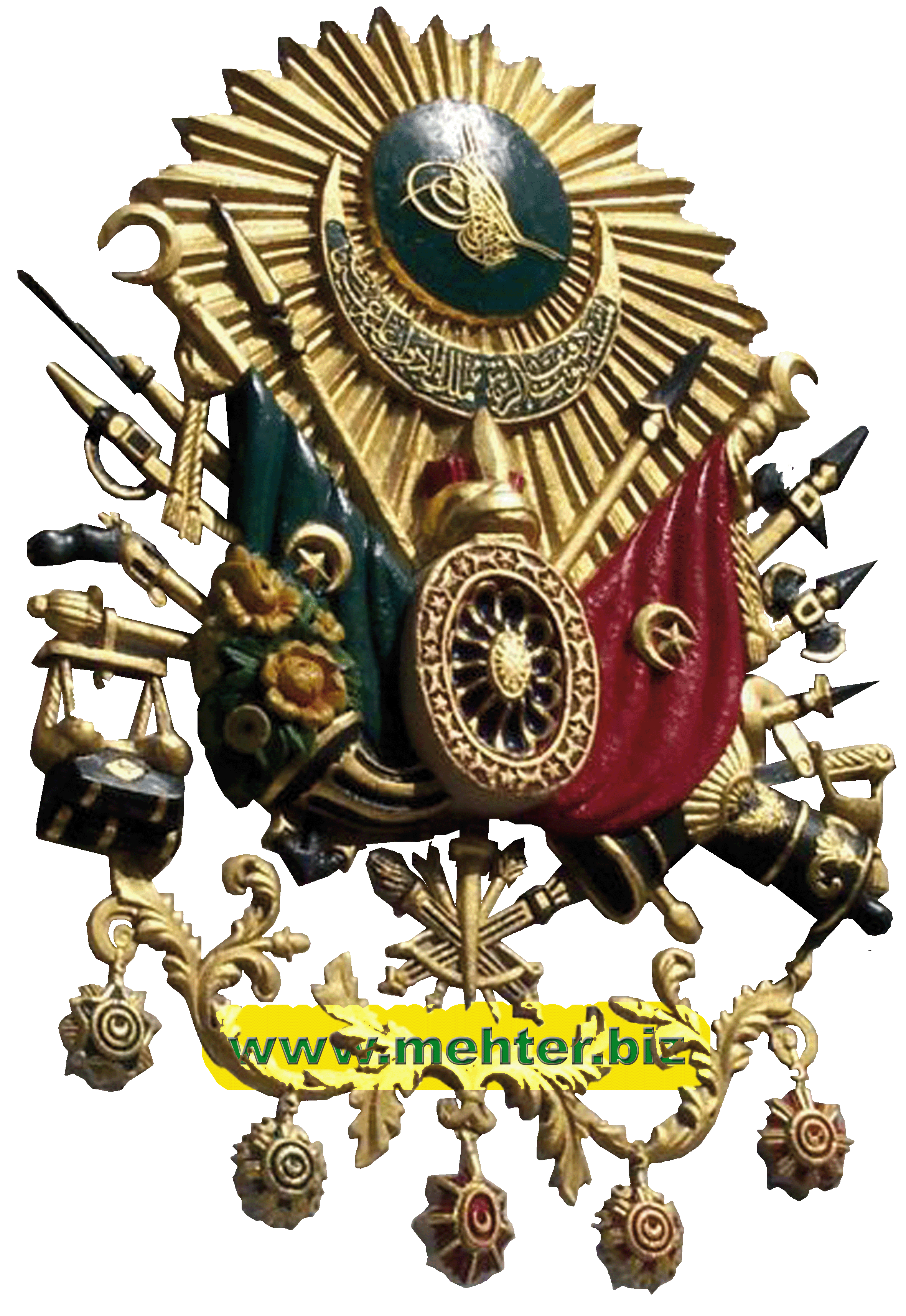 |
|
HISTORY OF
MEHTER |
WHAT IS MEHTER
Mehter is the
association of friendship, unity, heroism. Keeping alive to Mehter
with its own specific features and delivering to next generation is
a duty of every Turk. Mehter has been used in a various meanings
like player of harmonica, maker of tent, and maker of archery bows.
Mehter is taken from Persian “MIHTER” word, and Ottomans used this
word by mean of “EXALTED-GREAT”. In our language, we use arabic
style of this word as “MEHTER”.
IMPORTANCE OF MEHTER
According to this topic, Evliya Çelebi delivering
following big event from Sultan Murat 4th time. “ They could not
decide for which one of the Architects and Mehters has more priority
in troop. To discuss on this subject, Chiefs of Architects and
Mehter went to Sultan Murat. Firstly Cheaf of Architect start to
speak: My sultan!, Mehters are tradesmen without master, and they
are tribe of Dejjal who are working on art of Cemshid. We are
constructing big palaces, Selatin Mosques, bridges to our Sultan. We
have the neccesity role and we have duty in Islam army. Of course we
have more priority from mehters!.
Afterwards, Chief of Mehter start to talk: My
sultan!, Where ever you go, for mutual frienship, imperial majesty
and pomp, being hard, and reputation, against to friend and enemy
you have to go with beating drums, playing clarion, and kudüm (small
drums). In battle ground, to send the ghazis to the war, we beat the
mallets to the kettle drums. We make soldiers to become eager. If
our sultan gets upset, in front of him, we make twelve mode, twenty
four section, twenty four sul, forty eight compounds of complete
musical partition, and make our sultan cheering up. Old philosoghers
says; Music and song singers gives happiness to humans mind. We are
the tradesmens who feeds the souls. Especially where flag of Prophet
of God exists, Majesty of Ottoman dynesty needs to be there.
After
these talks Sultan 4th Murat decides mehters to pass prior then
architects.
MEHTER IN CONQUEST OF ISTANBUL
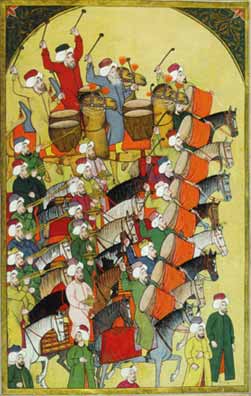 Conqueror
Sultan Muhammed II, in one early in the morning during the conquest
went to artilleryman. During the fire of cannons, thousands of
learned men in Okmeydani arena start to letting become great. Just
imagine a mehteran with hundreds of drums and shrill pipes. With
Ottoman army, they are in the battle arena. After Conqueror Sultan
Muhammed II arrives in front of city walls of Istanbul, 100 shrill
pipes, 70 drums was beating without stopping, makes hearts and souls
more excitement and exuberance. Also Second Mehter in Okmeydani
increases the longing desires of war of detachments in front of
Halic ramparts. Thewy makes horrible voices looks like thunder which
makes shiver of human soul. They were even suppressing the louds of
cannons. Again, in the middle of the great victory troops which was
entered to Istanbul, Conqueror Sultan Muhammed II stared his ayes to
destroyed ramparts, then rides his horse forward. Beside squadrons,
mehteran behind the corps of Janissaries, was beating drums and
shrill pipes, playing war songs and adding happiness to this happy
day wich closed one period and opened another in timeline. After the
victories azan was reciting and mehter was playing. Conqueror
Sultan Muhammed II, in one early in the morning during the conquest
went to artilleryman. During the fire of cannons, thousands of
learned men in Okmeydani arena start to letting become great. Just
imagine a mehteran with hundreds of drums and shrill pipes. With
Ottoman army, they are in the battle arena. After Conqueror Sultan
Muhammed II arrives in front of city walls of Istanbul, 100 shrill
pipes, 70 drums was beating without stopping, makes hearts and souls
more excitement and exuberance. Also Second Mehter in Okmeydani
increases the longing desires of war of detachments in front of
Halic ramparts. Thewy makes horrible voices looks like thunder which
makes shiver of human soul. They were even suppressing the louds of
cannons. Again, in the middle of the great victory troops which was
entered to Istanbul, Conqueror Sultan Muhammed II stared his ayes to
destroyed ramparts, then rides his horse forward. Beside squadrons,
mehteran behind the corps of Janissaries, was beating drums and
shrill pipes, playing war songs and adding happiness to this happy
day wich closed one period and opened another in timeline. After the
victories azan was reciting and mehter was playing.
HOW MEHTER MUSIC EFFECTED
TO EUROPE
From 18th Century, in
a lots countries, by impressing from mehteran groups, they started
to deploy similar groups.
Composer Mozart and Haydn are also impressed from
mehter music and created their famous compositions.
Last part of Famous German composer Beethoven’s
big symphony was ending with mehters kettle drums, drums, and shrill
pipes sounds. It is known fact that Beethoven adapted his
Turk March from one of the mehters war song.
Again Austrian composer Mozart composed Turk March,
in which he used “Allah Allah (God God)” sounds as a refrain.
German composer Wagner has been got excited while
listening mehter concert, and with telling “ this is the music”, he
expressed his feeling concerning mehter.
In 18th Century, Austrians, Russians, Germans, and
Frenchs get effected from mehter organization, and assambled their
own harmonica teams.
HISTORY OF MEHTER
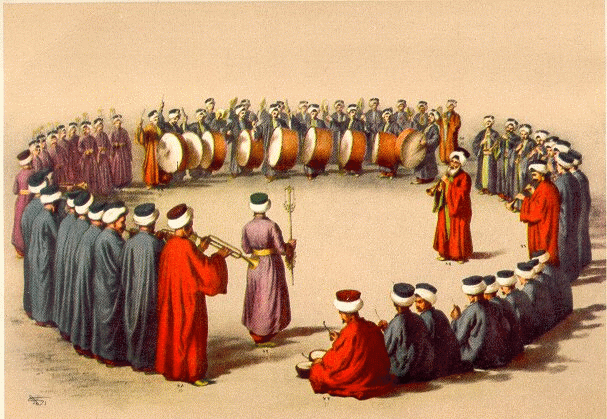
Mehter is the oldest arm band in
the world. In Hun times, the name was Tuğ, and it was established by
wind instrument and beat drums. After Conqueror name become Mehter.
The aim of this music, with its foreign chronic sound which can be
heard from far away, look like thunder, demoralize the enemy,
forcing them to give up fighting, conquering them without leading
massacre.
We
meet mehter in Orhun Inscriptions. In these Inscriptions, this band
is named as “Kuburge” and “Tug”. Divan-u Lugat-it Turk wich is
written in 11th century, explains that this band has been making
music in front of Khans. In those times, “Tugs” are forming by
kuvruk (kettle drum), tomruk (drum), cenk (bell), and nay-i Turk.
This band was making a music in wars and special days. Tug was the
symbol of judgeship of in Turks.
Before
the Ottomans, Seljuks had Tabilhane and Nevbethane societies which
formed by two wind, and four beat, total six main musical
instruments. After islam name of these instruments are converted to
shrill pipe, horn (nefir, sahnay), cevgan, bell, drum and kettle
drum, boygur, coken, cang, tumruk and kuvruk. In wars, kettle drum,
drum, nakkare (beater of a large drum), bell, cevgan, calpara, cengi
habi, shrill pipe and horn was going in front. Music was composed
specially for war, ceromonies, sport events.
Before the Ottomans, Osman Ghazi, won several wars
against to the Byzantion, and extended his lands. After these wars
Osman Ghazi, to show his usefulness to ruler of Seljuk Alaaddin
Keykubat, sent him war spoils. Osman Ghazi also conquered Inegol
Castle and expend his states lands. Seljuk Ruler Alaaddin be pleased
from these events and sent decree to Osman Ghazi with his man BLACK
BALABAN CAVUS to celebrate him. Alaaddin also sent tug as a symbol
of independence and rulership, Alem Tabil (Drum), Nakkare (Large
kettle drum - CIFTENARA) as a symbol of equity, and white colour
flag as a symbol of justice. Called by Ottamnas as TABLI AL’i OSMAN
(Drums of Ottoman Dinesty), in 1289, first mehter concert (nevbet)
is given to Osman Ghazi and his arm company in a small mosque arena
of Sogut town belong to Bilecik city. Osman Ghazi and the others
listened this concert with standing, because of the respect to
Seljuk ruler. And all other Ottoman rulers did the same thing.
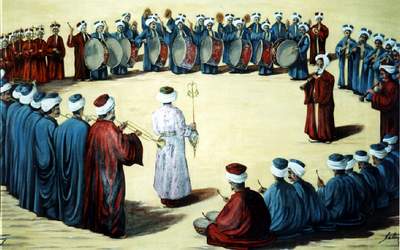
In mehter, singing several songs one after another
is called Beating Nevbet. Mehterhane-i Hakani (Mehter belongs to
Sultan) was beating Nevbet five a day before each prying. After
Muhammet II they started to play just before mid-afternoon prying.
Also in pertaining to royal accessions, when good news about victory
comes, sward parades, eve of the council of state, birthdays of the
sultans and princes of the Ottoman dinesty, circumcision ceromonies,
Nevbet was beated. In peace times Mehterhane-i Hakani was beating
Nevbet in its special place, in war time they were in front of the
Sultans (or commander) tent. End of the 17th Century, and in 18th
Century, in Demirkapi place in Topkapi Palace, also Eyup Sultan,
Kasimpasa, Galata, Tophane, Besiktas, Rumelihisari, Yenikoy, Kavak,
Beykoz, Anadoluhisari, Uskudar nights after midnight prays, before
sun rises to wake up people to morning praying Nevbet was beated.
Hadidi ratifies this event and tells:
Presently there is a custom in Sultans
They stand while beating Nevbet.
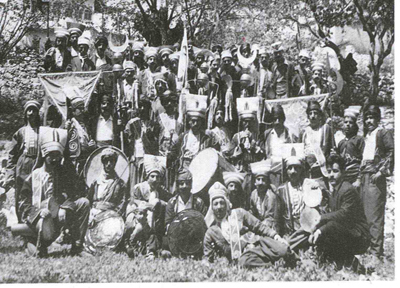
During hundreds of years in three continents (Asia,
Africa, and Europe), Mehter played imported role in military
expeditions. Especially in the wars, because of the negative effects
on their soldiers, enemy was attacking Mehter team even before
Ottoman Flag corps. In 16th, 17th and 18th Century, Mehter music fed
by great composers and performers and reached its most popular time.
These mehters were together with ambassadors on their visits, and
effected firstly to armies, and then the composers in europe. In
1683, Jan Sobiesky’s army had mehter kind band in Viana expedition.
Europiens mostly called this music as Janissaries music. Firstly
Polishes appllied this music in their organizations. At 1741,
Austria, Rusia, Prussia, and England came behind.
Mehter keeps its growing untill 1826. At this date
Mehter is closed by Sultan Mahmut II. Instead of mehter, with
designating Giuseppe Donizetti who is retired band chief of
Napolyon, they built up Mizika-i Humayun as copy of West palace band.
In 1914, to keep alive the oldest army band Mehters
established again by military museum. In these period, for symbolic
presentation, group of janissaries added in to mehter team. Thus,
historical identity has been added to mehter which deployed in
military museum. During the 1st World war, Revolution war and
begining of the first years of the republic mehter was a live. In
1935, it is cancelled again.
In 1952, Mehter is deployed again by Military Museum,
and it became pioneer to other mehter groups.
MEHTER IN TODAYS EUROPE
Historical “Mehteran Team” is established in
Bielefeld - Germany at 1998 by association president Erdogan AKTAS
by the name of Turkish Culturel and Social Service Society – Mevlana
Mosque (Society of Ideal).
Fatih Mehter Team, is the first “MEHTER TEAM”, which
is established in Europe, and kept giving service till now. Since
the first day its established, Fatih Mehter Team kept growing
professional carrier and became demanded team in Europe.
Since 1998, lots of concert inside and outside of
Germany has been performed, and represents Historical Mehter Team in
International and National Organizations, special days and nights.
Fatih Mehter team is also has been subjected on news in TVs and
Radios, and still is keeps going.
Our community, included three stage of mehter, has
been performed lots of concerts in various cities inGermany, also
outside of Germany, Denmark, Nedherland, Belgium, France,
Switzerland, Austria etc. with spacious classical and modern mehter
repertoire.
Fatih Mehter
Team has important added value on adaptation and integration of
Culturel and artistic activities on Europe.
ESTABLISHMENT PURPOSE OF MEHTER IN EUROPE
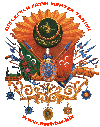
As we are adapted our lifes to Europe, Our target is
to present culturel reachness of Muslim Turk Nation which comes from
the history to European people.
Founder: By the name of Bielefeld Turkish culturel
and social services association – Mevlana Mosque, presedent of that
period Mr. Erdogan AKTAŞ
MEHTER IS DEVIDED IN TO TWO SECTION
Gait of Mehter Team in the ceremonies: In front,
Commander of the Mehteran with tall cap formerly worn by officers
of the janissaries, behind of him on the left side green banner with
armoured guard, in the middle white banner as a symbol of
independence, right side red banner with armoured guard stands.
Behind of the banners, there are 9 pennants for the standart to go
the forth grouped as three branches with three lines each. At the
right side behind of the red banner, there is a attack pennant
carried by the jannissaries. After the pennants in the middle master
of mehter stands, and after him there are group of cevgen (singers),
zurnazen (horn blower), boruzen (trumpeter), nakkarezen (beater of
a large drum), zilzen (beater of cymbels) and davulzen (itinerant
drummer) with double the amount of mehter. At the rear side there is
a very large kettle drum carried by the horse.
Mehter team could be consist of layers, and named
by 3 layer, 5 layer, 7 layer, 9 layer, 11 layer and 13 layer. The
smallest one is with 3 layer, and the largest one is with 13 layer.
The layer in mehter means the times of enstruments quantity. An
example in 5 layer Mehter team there are 5 horns, 5 trumpets, 5
large drums, 5 cymbels, 5 kettle drums, and 10 cevgens (singers) (double
quantity of other enstruments) etc. 13 layered Mehter is belongs
only the Sultan.
GAIT AND LINE UP STYLE OF
MEHTER
Mehter team has its own specific gait style.
Gait allways starts with saying besmele (to
pronounce the formula of bismillah) and with right step. During the
walk in every three step, team turnes right and left side, which is
a greet to left and right side by the means of RAHIMALLAH -
KHARIMALLAH in the walk. It is not two step forward and one step
back just like some people think.
CONCERT ORGANIZATION
At the beginning, Mehter was arranging as a circle,
afterwards they started to line up bas semicircle (crescent).
Mehteran construct a regular turn of action in a circular shape,
beaters of large drum sit down while the others stand in a shape of
semicircle. Large kettle drum are located in fron at the middle of
semicircle. Just before mehter concert starts, sergeant major gets
out of from circle and shout “ Vakti Sururu sefa Mehterbası Aga! (it
is time for happiness Master of Mehteran Lord ) Hey! Hey!”. To get
attention from audiance, large drums throwed three tempo in sofyan (dervishes)
style. While large drumms beated, Master of Mehter lord came in
front of team and yells “ Hello hey Mehteran!” and puts his right
hand on his chest and gives salut. All the team together put their
right hands on chest and salut back “Hello Master of Mehter lord”.
After, Master of Mehter lord yells “Hasduuuuuur” and tells name and
mode of song. Right after with yelling “Come on ya God !”, he let
Mehter to start concert. After finishing concert, special Mehter
pray is done and musical partition is completed.
MUSIC OF MEHTER
Music of Mehter is consist of unique sound which
modes and fundemental notes from Classical Turkish Music is being
used. It has forms like pesrev (a preloude, an overture), semai (colloquial),
nakis, cengi harbi (pertaining to war), murabba (a poem of four feet
to each distich that may be read horizontally or perpendicularly),
kalenderi (a small shelter tent). In Mehter repertoire some other
kinds of land border style songs. In the mean time, some Mehter
overtures played in Fasil music (special to Turkish Classical Music
which complete musical partition containing prelude and the
evoluation of a certain mode). In Mehter music, there are some music
forms like ahlati, revani, saf which are not the part of Fasil music.
The compositions of Mehter musics are created by
musicians which on duty in Mehterhane (Mehter Instituon). The oldest
compositions arrived todays were created by biggest musicians like
Nefiri Behram, Emir-i Hac, Hasan Can, and 2nd Gazi Giray from 16th
Century. Compositions which have musical notes mainly came from 17th
Century. Some biggest composers from this time are Horn blower Dagi
Ahmet Celebi from Edirne city, master of horn blower Ibrahim Lord,
Mustakim, Hammali and Shah Murad. Also Master Hızır is one of the
biggest composer from 18th Century. Composers from 16th and 17th
Centuries are in the form of pesrev and they are published in
Mecmua-i Saz u Soz (Musical Magazine) by Mr. Ali Ufki. Also They
arrived todays with the helps of some historical book Kitabi Ilmıl-Musiki
ala Vechi’l-Hurufat which is known by Kantemiroglu Edvari.
Mehter not plays only marches. It has own special
semai, kar, karce, fasil style songs, land border and Rumeli (Turkey
lands in Europe) songs, pesrev and enstrument colloquials also
included in Mehter repertoire.
MEHTER CLOTHES
Chiefs of
enstrument beaters wear red long skirts, red wedded hat, red baggy
trousers, yellow handkerchiefs. Other enstrument beaters wear dark
blue long skirt, wedded hat, baggy trouser and red handkerchief.
Singers wear like chief of enstrument beaters.
SOME MEHTER COMMANDS AND EQUIPMENTS AND THEIR
MEANINGS |